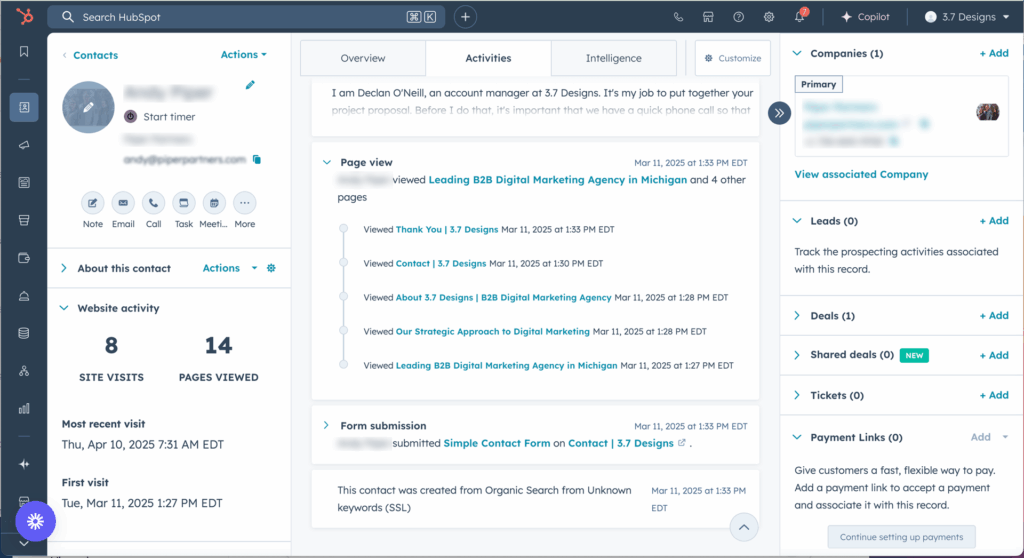- Digital Marketing
- Hubspot
- Updated 09/30/2025
llms.txt Explained: What to Share, What to Block, and What Actually Matters

AI assistants aren’t just knocking on the door—they’ve kicked it open. ChatGPT, Perplexity, Gemini, and others don’t bother with ten blue links. They answer the question right there, in real time. That’s fantastic for users, but it leaves marketers uneasy. If AI is quoting content, should we be blocking anything? And does adding an llms.txt file magically boost visibility?
Spoiler: it doesn’t. llms.txt is a way to curate, not a way to rank. Think of it as putting your best outfit on before walking into the spotlight. It doesn’t make the spotlight shine brighter—it just makes sure you don’t get quoted wearing sweatpants.
What llms.txt Actually Is (and Isn’t)
At its simplest, llms.txt is just a plain text file that lives at the root of your site (/llms.txt). Inside it, you list the content you want large language models to reference—the polished guides, the evergreen FAQs, the research that actually represents your brand.
It is not robots.txt. It is not your sitemap. And it is definitely not some secret SEO switch you flip to leapfrog into ChatGPT answers. Right now, adoption across AI tools is spotty at best. But adding it now is a bet on the future. You’re handing AI assistants the right materials before the practice becomes standard.
llms.txt vs robots.txt: Key Differences
If robots.txt is the bouncer deciding who gets in, llms.txt is the VIP list. Robots.txt tells crawlers what they can or can’t touch; llms.txt points AI assistants to the pages worth quoting. Different jobs, complementary tools. Don’t confuse the two.

What LLMs Actually Pay Attention To
Spoiler: they’re picky. Even if you hand-feed them your greatest hits in llms.txt, they Even with a beautifully written llms.txt file, large language models don’t just take your word for it. They still decide what’s trustworthy based on the same things Google has been hammering for years: expertise, experience, authority, and trustworthiness. That means visible authorship, real bios, organizational identity, and citations.
They also prize content that’s structured for clarity. Short paragraphs, scannable headings, tables instead of long rambles—these things matter because they’re easy to parse. Freshness counts, too. Content that shows it’s been recently updated or reviewed is far more likely to be trusted. And, just like users, AI assistants prefer pages that load cleanly without pop-ups or JavaScript gymnastics.
Should You Block Anything?
Most of the time, the answer is no. Blocking content from AI doesn’t protect you; it just makes you invisible. The exceptions are when something is outdated, context-dependent, or sensitive. Old pricing pages and deprecated features? Don’t feed them to AI. Legal copy that requires careful context? Probably not safe to summarize. Internal docs that were never meant for public eyes? Definitely block those.
The simplest test is this: if you’d be uncomfortable seeing the content quoted in a press article, don’t make it available to AI.
Myth vs Reality
One of the biggest myths is that llms.txt somehow boosts your rankings. It doesn’t. Trust signals and clarity are what earn you citations. Another misconception is that blocking aggressively will keep your intellectual property safe. In reality, over-blocking just wipes you off the map. And then there’s the schema myth—that structured data is irrelevant to AI. It’s not. Structure makes your content easier to parse and cite, which is exactly the game we’re playing.
Your llms.txt Playbook
So what’s the move? Start by actually creating an llms.txt file and putting it at your root domain. Use it to point AI toward your canon: your most authoritative guides, FAQs, and research pages. Then make sure those pages are anchored in E-E-A-T—real authors, dates, and a clear organizational identity.
As you update, focus on readability. Chunk your content into logical sections, lead with clear answers, and use entities and terms that AI can easily map. Finally, revisit the file every quarter. Trim what’s outdated, add what’s new, and keep the signal strong.
The bottom line
llms.txt won’t rocket you into AI answers on its own. It’s not magic—it’s maintenance. Use it to curate, block sparingly, and double down on the signals that actually earn you citations: authority, clarity, and freshness.
Or, put it this way: llms.txt gets you noticed. E-E-A-T gets you remembered.